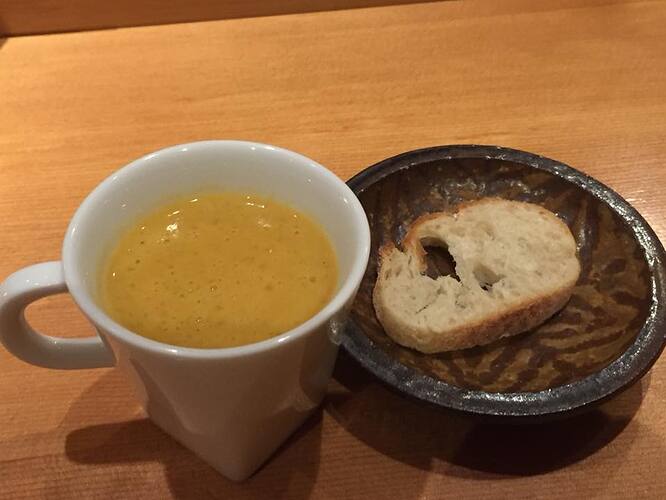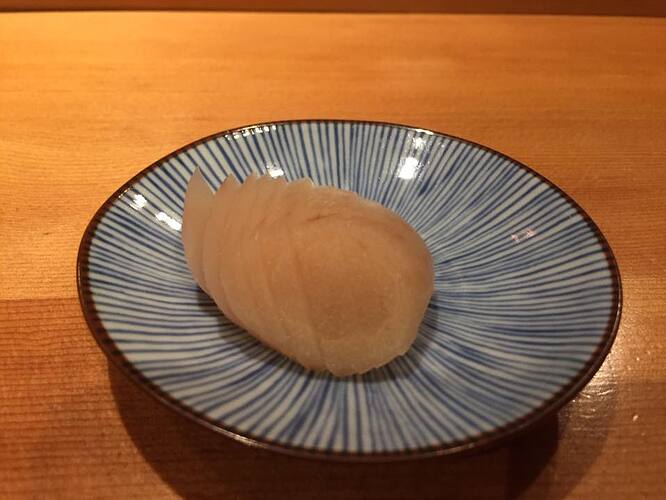T’was a lightly rainy evening. After exploring Futagotamagawa, it was time to head to the highly anticipated Sushi Kimura.
Got seated close enough to the fish case. Lots of aged deliciousness on display!
To start, a broth made entirely with hamaguri
Next up: shima ebi with shiokara (fermented shrimp guts) mixed in
The “pasta” course… soba with uni sauce. Unconventional!
Found out Kimura san also offers hot sake, so why not? It was chilly outside, so something warm and soothing would be great. Nobody gives a flying magnum generally about hot sake, not even the instagrammers. This was totally unexplored territory! What’s amazing is that Kimura san is also his own sake somm, and while he is preparing appetizers, nigiri etc for the guests, he also warms up the sake and monitors the temperature!
Here to start is a Shizuoka prefecture brewery “Kikusui” with a signature Tokubetsu Honjozo. Much later I would learn this is a cult classic amongst the hardcore Japanese sake drinkers. Very easy to like and quite impressionable as the first warm sake.
Iwashi sumire in dashi, very very good.
Mushi shirako (risotto)
Nameta garei from Aomori prefecture. This was a supreme delight to have!!
A number of sushi chefs generally take the fish parts that are not used for sushi and make a clear broth out of it or enhance it a little with miso. This mixture is taken to the next level, an almost European bisque like approach. It is made with mixed fish parts (no doubt the aged fish carcass/bones), vegetables, sushi rice. Kimura san joked this was “cappuccino”. Seafood cappuccino to be exact.
Next comes a preview of his sushi rice to set the tone for the nigiri course of the evening. It’s just seaweed and shari. The shari is very warm, sour but has an incredible aroma and lots of umami. This is attributed to the organic premium pure rice vinegar from Kyoto prefecture he uses that is of a light to medium darker shade that can sometimes be mistaken for akasu, though there are debates as to whether he blends akasu and komesu. Either way this rice is damn good.
Next hot sake: Asahikiku Daichi, I believe this was a Junmai Ginjo, brewed with Yamadanishiki rice and the rice was cultivated without pesticides. Furthermore it was one of the first Fukuoka prefecture sake I’ve ever had. Unfortunately I don’t remember much about this one…
Nigiri time! First time, sumi ika, aged one week
Next, is Kue, aged two weeks
Ginger slices
Kawahagi aged five days, with its liver between the shari and the neta
Next up is baby bluefin, or commonly called meiji maguro (meiji for short). The baby bluefin tunas for some reason tend to swim alongside katsuo, and when net caught, usually results in both. Always a short reason and very hard to come by. The preparation is done katsuo tattaki style, and is smoked with straw. Prior to the straw smoking, it was aged for 10 days. I recall this being one of the best pieces of the evening. It was like a hybrid bluefin otoro and katsuo mixed together, absolutely sublime.
Kohada, and I’ve never had it aged this long…20 days! Excellent!
Sujiko, aged three weeks. Terrific
Buri, aged one month
Iwashi, aged one week. Literally pornographic
At this point I took a video of Kimura san whipping out a gigantic black abalone (kuro awabi), from Chiba prefecture. He was doing very delicate ridge/see saw like thin slicing, and meticulously at that. The result was a wonderfully textured/bite of a nigiri, of an extremely delicious prized specimen.
The most instagrammed item was my least favorite. Makajiki (marlin) aged 51 days. I did not find it to be coffee flavored or cafe au lait but I think I got where people came from with this reference. A very unusual style of aging/marination
My favorite hot sake of the evening. Shinkame Hikomago 3 year aged Junmai. The most remarkable of all the sake poured so far.
His anago is also very good
This was a sake on the regular menu at the time of visit that I was dying to try. This is a very small producer that only sells to about 6 to 8 shops nationwide in Japan, and only one shop in Tokyo carries it retail. Sari Junmai Daiginjo from Fukui prefecture, polished to 50% and they brewed it to pair with sushi. It was good to have this as a closer, the bottle was chilled and quite refreshing. Unfortunately did not get to pair this with sushi.
His tamagoyaki was pretty good, and it was made with amadai that was aged two weeks (grounded to a paste and mixed in with eggs). There is a growing trend to move away from using ground shrimp (typically shiba ebi) due to growing number of shellfish allergies mostly by foreign visitors.
This was the first sushi meal in town, maybe 2nd day upon arrival. Was the the absolute best sushi of the trip? Interestingly, not really. It was good, but it was not earth shattering enough to me. From a sake lover’s point of view, none of the sake were perfect matches with the food either, but they were great on their own.
One thing to note is that extensive aging of fish, is not classic Edomae. People are trying to come up with new things and of course there are plenty of bandwagon jumpers. Even with that said, visiting here can be quite educational if you can get a reservation. Come here because you want to learn and discover yourself, not because of jetsetting instagram VIPs…some of which their tastes can be a bit…interesting.


































